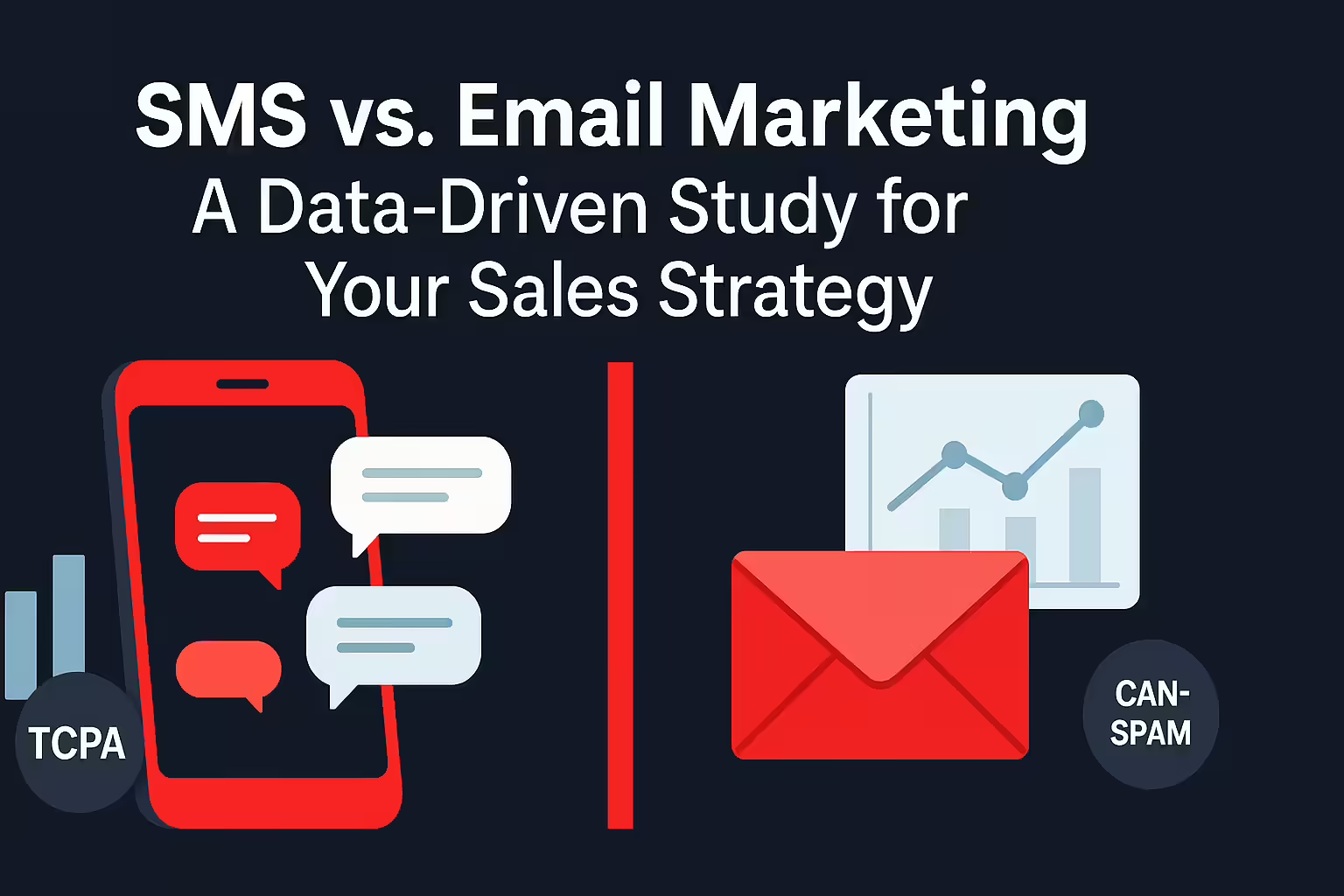TL;DR: SMS marketing outperforms email in every engagement metric, boasting a ~98% open rate compared to email's ~20-45%. SMS is the clear winner for time-sensitive promotions, alerts, and driving immediate action. Email remains essential for delivering detailed content, building brand narratives, and nurturing long-term customer relationships. The most effective strategy isn't choosing one over the other, but integrating both into automated workflows that use each channel's strengths—SMS for urgency and email for depth.
SMS vs. Email Marketing Statistics: A Head-to-Head Comparison
| Performance Metric | SMS Marketing | Email Marketing | Source(s) & Notes |
| Open Rate | ~98% | ~20-45% | Note: Email open rates vary significantly by industry and are impacted by factors like Apple's Mail Privacy Protection. |
| Click-Through Rate (CTR) | ~18-36% | ~1.5-5% | Note: SMS CTR is significantly higher due to lower message volume and higher recipient intent. |
| Conversion Rate | ~21-40% | ~1-15% | Note: Definitions of "conversion" can vary. SMS excels at immediate, low-friction conversions. |
| Response Rate | ~45% | ~6% | Note: This highlights the conversational, two-way nature of SMS. |
| Return on Investment (ROI) | $21-$71 per $1 spent | ~$36 per $1 spent | Note: SMS ROI figures show wide variance but consistently outperform most channels. |
| Time to Read/Respond | 95% read in 3 mins; 90% respond in 30 mins | Variable; ~90 mins to open | Note: This immediacy is the core differentiator driving SMS performance. |
The central challenge for every sales and marketing team is the relentless battle for customer attention. Audiences are inundated with a constant stream of messages, notifications, and advertisements, creating a level of noise that makes meaningful connection incredibly difficult. To cut through this clutter, businesses rely on two primary channels for direct outreach: email, the established workhorse of digital communication, and SMS, the agile contender delivering messages with unparalleled immediacy.
The debate often centers on which channel is superior. However, this perspective is flawed. A truly effective communication strategy recognizes that while performance statistics overwhelmingly favor SMS for speed and engagement, email remains unmatched for delivering detailed content and nurturing long-term relationships. The ultimate advantage lies not in choosing one over the other, but in strategically integrating both into a unified, automated communication engine.
This report provides a definitive, data-driven analysis of SMS and email marketing. It begins with a head-to-head statistical comparison of key performance indicators, decodes the psychological and practical reasons behind these numbers, and offers a strategic playbook for when to deploy each channel. Finally, it provides a blueprint for building powerful, integrated workflows that leverage the unique strengths of both, transforming a simple outreach plan into a sophisticated sales and engagement machine.
SMS Marketing & Omnichannel Communication
What is the real ROI of SMS marketing for a business in 2025? On average, businesses generate an extraordinary $71 for every $1 spent on SMS marketing campaigns. This return can nearly double that of email marketing, and for time-sensitive campaigns like flash sales, ROI rates have been reported to exceed 3,000%.
How do SMS open and response rates compare to email marketing? The performance gap is significant. SMS campaigns achieve open rates as high as 98%, with 90% of messages read within three minutes. This is nearly five times more effective than email, which has an average open rate of around 20-28%. Furthermore, the average response rate for SMS is 45%, compared to just 6% for email.
Do customers actually want to receive text messages from businesses? Yes, consumer preference for SMS is growing rapidly. In 2025, an overwhelming 84% to 86% of consumers have opted-in to receive text messages from businesses. A full 91% of customers state that they want to receive texts from the businesses they interact with.
How quickly do consumers expect a business to respond to a text message? Immediacy is crucial. Recent reports show that 71% of customers expect a response from a business via text within just 15 minutes of reaching out.
What is the best way to integrate SMS into an existing sales strategy? The most effective approach is to use SMS as part of a unified, omnichannel strategy rather than a standalone tool. Use it for high-immediacy touchpoints like appointment confirmations, follow-ups after a voicemail, or sharing time-sensitive information. The goal is not to replace phone calls or emails but to augment them, ensuring the right message is delivered through the right channel at the right time.
Sales Dialer Productivity & AI
How much more productive can a sales team be with a power dialer vs. manual dialing? The efficiency gains are dramatic. Implementing an auto-dialer can increase a team's calling efficiency by 200-300%. A power dialer specifically can make a single agent 60% more productive than one using manual dialing methods.
What is the real impact of AI-powered local presence on call answer rates? Using a local area code for outbound calls can dramatically increase connection rates. Studies show that AI-powered Local Presence dialing, which automatically displays a local number to the prospect, can increase call answer rates by up to 400%.
What is the average success rate for cold calling in 2025? The average success rate for a cold call—defined as booking a meeting or advancing to a next step—hovers between 2% and 5%. A large 2025 study found the specific average to be 2.3%.
How many calls does it actually take to reach a prospect? Persistence is key in modern sales. On average, it takes eight cold call attempts just to reach a single prospect. However, 80% of all sales require five or more follow-up calls to close, yet 44% of reps give up after just one attempt.
What is the difference between a power dialer and a predictive dialer? Both automate outbound calling, but they operate differently. A power dialer dials one number at a time for an agent as soon as they are available, prioritizing call quality and allowing for prep time between conversations. A predictive dialer dials multiple numbers simultaneously and uses an algorithm to predict when an agent will be free, connecting only live answers to available agents. This maximizes call volume and is ideal for high-volume campaigns.
Revenue Operations (RevOps) & Strategy
How much faster do companies with RevOps actually grow their revenue? The impact on growth is substantial. Research from Forrester shows that organizations that have successfully implemented a Revenue Operations model grow revenue nearly three times faster than their peers who have not.
What is the tangible ROI of implementing a Revenue Operations framework? Beyond faster revenue growth, the ROI is multifaceted. Public companies with RevOps have shown 71% higher stock performance. Additionally, Boston Consulting Group reported that RevOps adopters see a 10-20% increase in sales productivity and a 100-200% increase in digital marketing ROI.
How does aligning sales and marketing through RevOps affect closing deals? A core function of RevOps is to break down departmental silos. Companies with tightly aligned sales and marketing functions—a key tenet of RevOps—generate 208% more revenue from their marketing efforts. This alignment makes them significantly more effective at converting leads and closing deals.
What are the most important metrics a RevOps team should track? RevOps focuses on holistic, cross-functional metrics. The most critical ones include Annual/Monthly Recurring Revenue (ARR/MRR), Customer Acquisition Cost (CAC), Customer Lifetime Value (CLV), Net Revenue Retention (NRR), sales cycle length, and pipeline velocity. According to a 2024 report, over 56% of RevOps professionals agree that ARR/MRR is the most useful metric for engaging with executive leadership.
By 2025, what percentage of high-growth companies are expected to use a RevOps model? The adoption of RevOps is becoming a standard for top-performing companies. According to Gartner, by 2025, 75% of the highest-growth companies globally will have implemented a Revenue Operations model to drive predictable growth.
SMS vs. Email Open Rates: Why SMS Has a 98% Open Rate
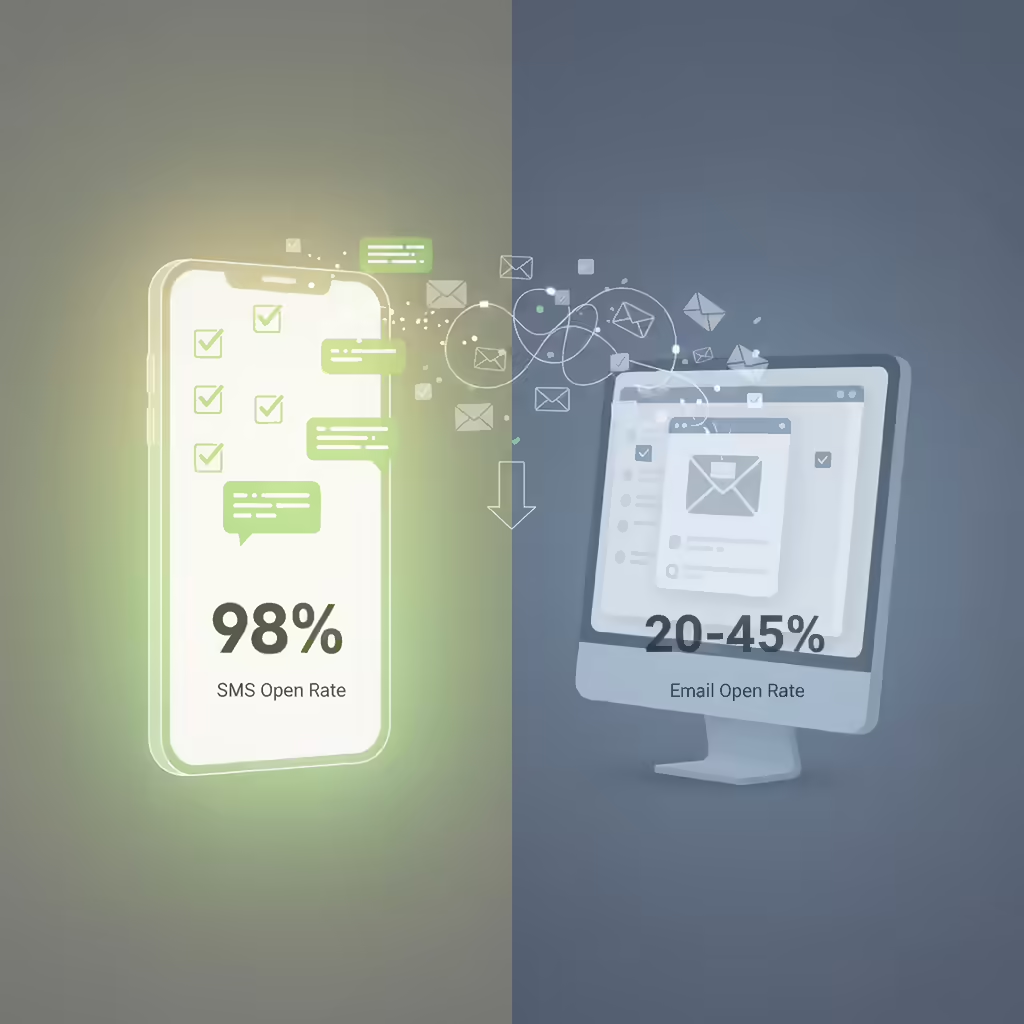
The most dramatic difference lies in the open rate. SMS marketing boasts a near-perfect open rate of approximately 98%. This means that for every 100 messages sent, 98 are seen by the recipient. This level of visibility is unparalleled in digital marketing. In contrast, email marketing open rates, while respectable, are significantly lower, with averages typically ranging from 20% to 45% depending on the industry and audience engagement. Even high-performing email campaigns struggle to reach half of their intended audience.
This disparity represents what can be considered an "attention tax" inherent to email marketing. Due to factors like inbox clutter, aggressive spam filters, and general consumer fatigue from receiving over 100 emails per day, a significant portion of any email campaign's potential impact is lost before the message is even seen. SMS, with its direct-to-lock-screen delivery and lower daily volume, bypasses this tax almost entirely, guaranteeing the message is delivered and noticed.
Click-Through and Conversion Rates: Comparing SMS and Email Performance
The exceptional open rate of SMS directly fuels its superior click-through rate (CTR) and conversion rate. With average CTRs ranging from 18% to as high as 36%, SMS consistently drives more traffic and action than email, which typically sees CTRs between 1.5% and 5%. This translates into higher conversion rates, with SMS campaigns reporting conversions between 21% and 40%, often ten times higher than the average email marketing conversion rate. While email can certainly drive conversions, the sheer volume of unopened messages creates a significant drop-off at the top of the funnel that SMS does not experience.
Response Rates and Speed: Why SMS is the More Immediate Channel
SMS is fundamentally a more interactive and immediate channel. It achieves an average response rate of 45%, compared to just 6% for email. This highlights the conversational nature of texting. Furthermore, the speed of engagement is staggering: 95% of text messages are read within three minutes of being received, and 90% of responses occur within 30 minutes. Emails, by contrast, can take an average of 90 minutes just to be opened, making them unsuitable for communications requiring an immediate reaction.
SMS vs. Email ROI: Which Channel Delivers a Better Return?
Both channels deliver an impressive return on investment. Email marketing has long been celebrated for its efficiency, generating an average of $36 for every $1 spent. However, the data for SMS is even more compelling, though it shows a wider variance. Reported ROI for SMS ranges from $21 to a staggering $71 for every dollar invested.
This wide range in SMS ROI is not an indicator of inconsistent data but rather a reflection of strategic nuance. The highest ROI figures are likely generated from highly targeted, time-sensitive campaigns with a clear call to action, such as abandoned cart reminders or flash sale alerts, which leverage the channel's immediacy for maximum effect. Broader, less urgent campaigns naturally yield a lower, though still highly impressive, return. This suggests that the ROI of an SMS program is directly proportional to the strategic quality of its implementation.
Why SMS Outperforms Email in Engagement
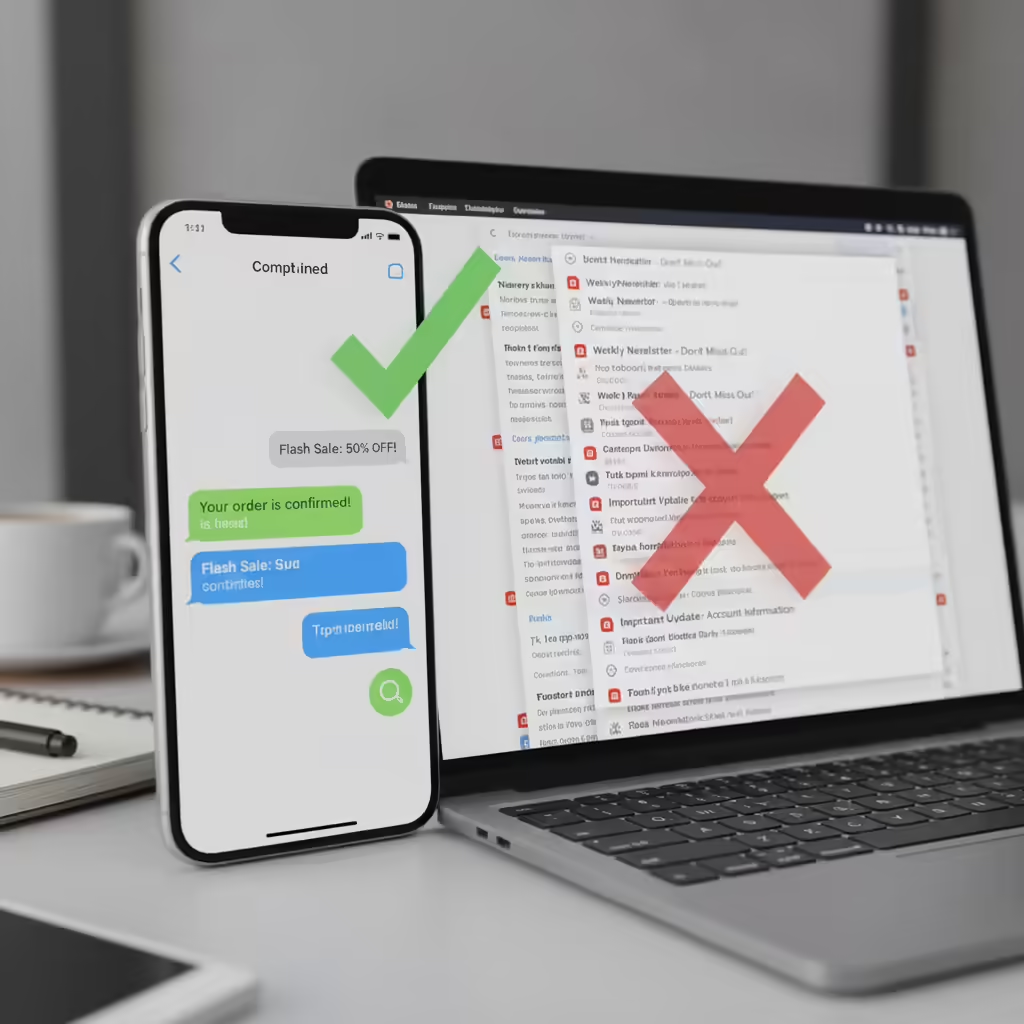
The statistical superiority of SMS in engagement metrics is not arbitrary. It is rooted in the fundamental differences in how consumers perceive, interact with, and prioritize these two channels. Understanding these underlying factors is crucial for developing an effective communication strategy.
Inbox Psychology: Why Texts Feel Personal and Emails Get Ignored
The SMS inbox is a deeply personal space, historically reserved for communication with friends, family, and a small circle of trusted contacts. An incoming text message carries a sense of personal importance and urgency. Conversely, the email inbox has evolved into a digital catch-all—a mailbox for everything from critical work correspondence and personal messages to newsletters, receipts, promotional offers, and a high volume of spam.
This distinction creates a significant psychological barrier for email marketers. Consumers receive an average of 100-120 emails per day, compared to fewer than 20 texts. This leads to "inbox fatigue," a state where users actively triage, delete, and ignore emails en masse simply to manage the volume. A text message notification, however, is a high-priority event that is almost always investigated immediately. The very nature that makes SMS so effective—its personal and interruptive quality—also means it carries a higher perceived cost of intrusion. Consumers have a much lower tolerance for irrelevant or overly frequent texts, which can lead to rapid opt-outs. Therefore, a successful SMS SMS strategyands a higher standard of value and relevance; brands must continuously earn the privilege of occupying that personal space.
The Power of Brevity: How SMS Character Limits Drive Action
The 160-character limit of a standard SMS message is often viewed as a limitation, but it is one of its greatest strategic strengths. This constraint forces marketers to be ruthlessly efficient with their messaging, stripping away fluff and focusing on a single, clear, and actionable point. The message is designed for immediate comprehension and response.
Email's flexibility in length and design is its own double-edged sword. While it is ideal for delivering rich, detailed content, longer emails can be visually intimidating and are often mentally filed away by the recipient to be read "later"—a time that may never arrive. This positions email as a "content destination," a place users go to consume information when they have time. SMS, in contrast, functions as a "notification layer" that sits on top of a user's daily activities, designed not for consumption but to trigger an immediate action. This is a critical strategic distinction: email is used to educate and inform, while SMS is used to activate and convert.
The Mobile-Native Advantage: Why SMS is the Most Accessible Channel
SMS is a native function of every mobile phone on the planet. It requires no internet connection to receive a message, no app to download, and no login to check. It is the most accessible form of digital communication. While most emails are also read on mobile devices, the experience is inherently more complex. It involves opening a dedicated app, navigating an interface, and dealing with notifications that are often bundled or silenced by the user or the operating system. An SMS arrives as a high-priority, individual push notification that commands immediate attention, making it the most direct and frictionless way to reach a user on their most personal device.
Strategic Use Cases: When to Use SMS vs. When to Use Email
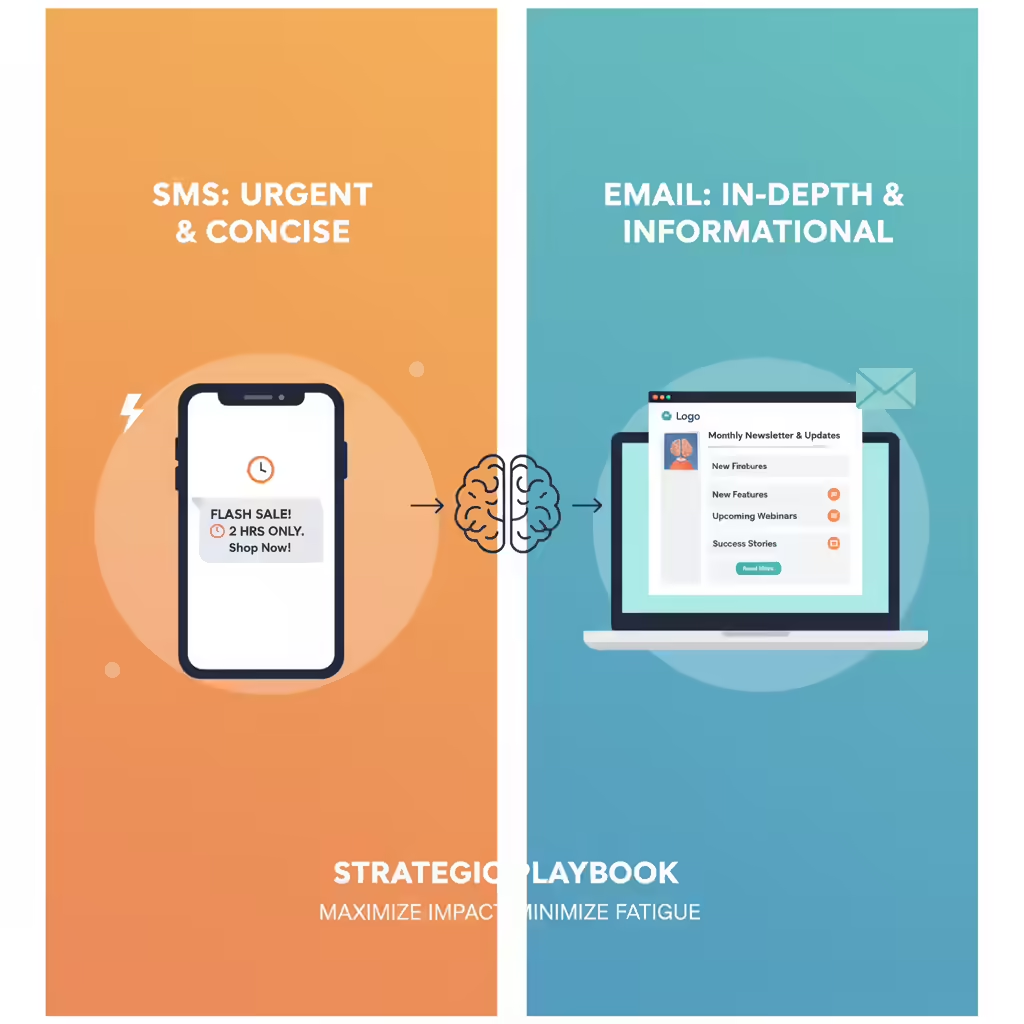
Understanding the "why" behind the data allows for the creation of a strategic playbook that deploys each channel for its intended purpose, maximizing impact and minimizing user fatigue.
Best Use Cases for SMS Marketing: Urgency, Promotions, and Alerts
The core strength of SMS is its ability to drive immediate action. It should be reserved for high-value, time-sensitive communications.
Time-Sensitive Promotions: SMS is the undisputed champion for flash sales, limited-time offers, and daily deals. The immediacy of the channel creates a powerful sense of urgency that email cannot replicate. Brands like Urban Outfitters and Function of Beauty effectively use this tactic to drive immediate sales spikes.
Transactional and Logistical Alerts: Communications like shipping confirmations, delivery updates, and appointment reminders are highly valued by customers. Using SMS for these alerts builds trust, improves the customer experience, and reduces the burden on customer service teams. A study of Denver Health found that patients who received text reminders attended their appointments 73% of the time, compared to 66% for those who did not.
High-Intent Follow-Ups: Abandoned cart reminders are a prime use case for SMS. A text sent within an hour of cart abandonment can recapture a significant amount of otherwise lost revenue by reaching the customer while their purchase intent is still high.
Customer Service and Feedback: The two-way nature of SMS makes it ideal for quick customer service interactions or for sending a post-purchase survey link to gather immediate feedback.
Best Use Cases for Email Marketing: Nurturing Leads and Delivering Detailed Content
Email excels where SMS falls short: delivering rich, detailed content and building relationships over time.
In-Depth Content and Storytelling: Welcome series, weekly newsletters, brand announcements, and educational content are perfectly suited for email. This channel provides the necessary space to build a brand narrative, establish thought leadership, and nurture a relationship with the audience.
Visually Rich Communication: Email's design flexibility allows for the showcasing of new product collections with high-resolution images, GIFs, embedded videos, and detailed descriptions—elements that are impossible to replicate in a standard SMS.
B2B Lead Nurturing: The B2B sales cycle is typically longer and involves multiple decision-makers who require detailed, shareable information. Email is the ideal channel for distributing white papers, case studies, and webinar invitations that educate and persuade a buying committee over time. For this reason, 59% of B2B marketers identify email as their most important channel for revenue generation.
Formal and Archival Communication: For sending invoices, detailed receipts, or updates to terms of service, email provides a more formal and easily archivable record that customers can reference later.
How to Integrate SMS and Email with Marketing Automation
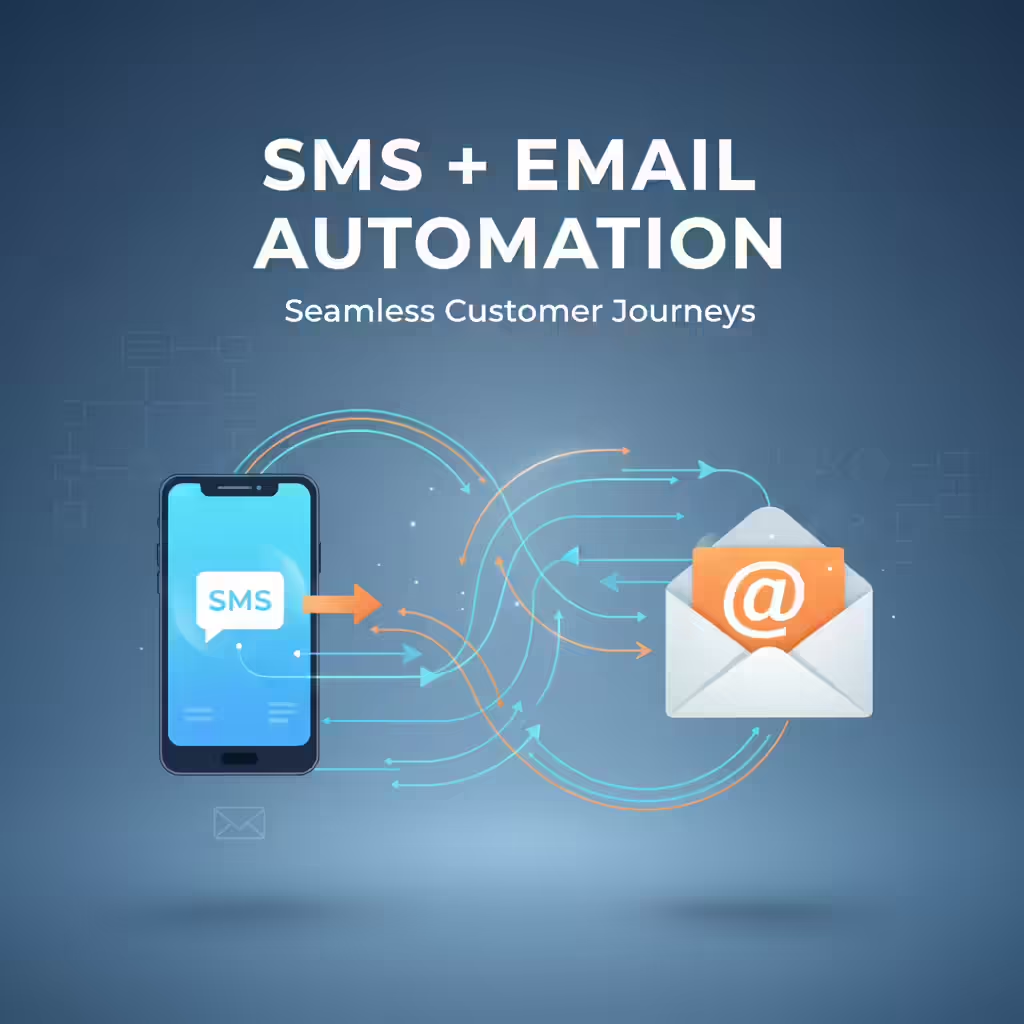
The most sophisticated and successful brands understand that the debate is not "SMS vs. Email" but "SMS and Email." By integrating these two channels into automated workflows, businesses can create a seamless, context-aware customer journey that leverages the strengths of both, guided by user behavior.
Creating an Omnichannel Strategy: Unifying the Customer Conversation
Customers do not view their interactions with a brand in terms of channels; they see a single, continuous conversation. A disjointed experience, where an SMS and an email are unaware of each other, can be jarring and inefficient. A true omnichannel strategy unifies this conversation by using a central data platform—such as a CRM integrated with a sasales engagementlatform like Kixie—where interactions on all channels are tracked in a single customer profile. This allows for intelligent automation where one channel's action (or inaction) can trigger a response on the other, ensuring the right message is delivered on the right channel at the right time.
3 Automated SMS and Email Workflow Examples
Managing a dual-channel strategy at scale is impossible without automation. The following workflows demonstrate how to combine SMS and email to drive superior results.
Workflow Example 1: Recover Abandoned Carts with SMS and Email
This workflow is designed to recover maximum revenue from high-intent shoppers.
Trigger: A customer adds items to their cart but does not complete the purchase.
Step 1 (1 hour post-abandonment): An automated Email is sent. This email should be visually rich, showcasing the exact products left in the cart, and can include social proof like customer reviews to build confidence.
Step 2 (4 hours post-abandonment, Condition: If email is not opened): An automated SMS is triggered. The message is short, direct, and creates urgency: "Hi [Name], still thinking it over? Your items are selling fast. Complete your purchase before they're gone: [link]".
Why it works: This sequence uses email's visual strengths first. If that fails to engage, it deploys SMS as a high-visibility, urgent nudge. This prevents "channel cannibalization"—where both channels send messages simultaneously, annoying the customer and muddying attribution data—by using conditional logic that is only possible on an integrated platform.
Workflow Example 2: Maximize Flash Sale Revenue
This workflow maximizes awareness and drives immediate action for time-sensitive promotions.
Trigger: A planned flash sale.
Step 1 (24 hours before sale): An Email is sent to the entire list, announcing the upcoming sale, showcasing featured products, and building anticipation.
Step 2 (Sale Launch): An SMS is sent to a VIP segment of past purchasers, offering them exclusive early access. "VIP Alert: Our 24-hour flash sale is LIVE! Shop now before everyone else: [link]".
Step 3 (2 hours before sale ends): A final reminder SMS is sent to all subscribers who have not yet made a purchase. "Last chance! Our flash sale ends in 2 hours. Don't miss out on 40% off: [link]".
Why it works: The workflow uses email for broad awareness and SMS for high-impact, time-sensitive triggers that drive urgency and reward loyalty.
Workflow Example 3: Automate B2B Lead Follow-Up
This workflow bridges the gap between marketing-generated interest and a sales conversation.
Trigger: A lead downloads a white paper or registers for a webinar.
Step 1 (Immediate): An automated Email delivers the requested content and thanks the lead for their interest.
Step 2 (Day 2): A follow-up Email provides a related case study or blog post, further establishing expertise and nurturing the lead.
Step 3 (Day 3, Condition: If lead has opened both emails): An automated SMS is triggered from the assigned sales representative's number. "Hi [Name], it's from Kixie. I saw you were checking out our content on sales automation. Is this a priority for your team right now?".
Why it works: This elevates SMS from a simple marketing tool to a powerful sales engagement tool. The automation is triggered by marketing engagement, but the message comes from a sales rep, creating a seamless and timely handoff. It transforms a one-to-many marketing broadcast into a personalized, one-to-one sales conversation starter at the moment of peak interest, dramatically increasing the likelihood of a connection.
SMS and Email Marketing Compliance: A Guide to TCPA and CAN-SPAM
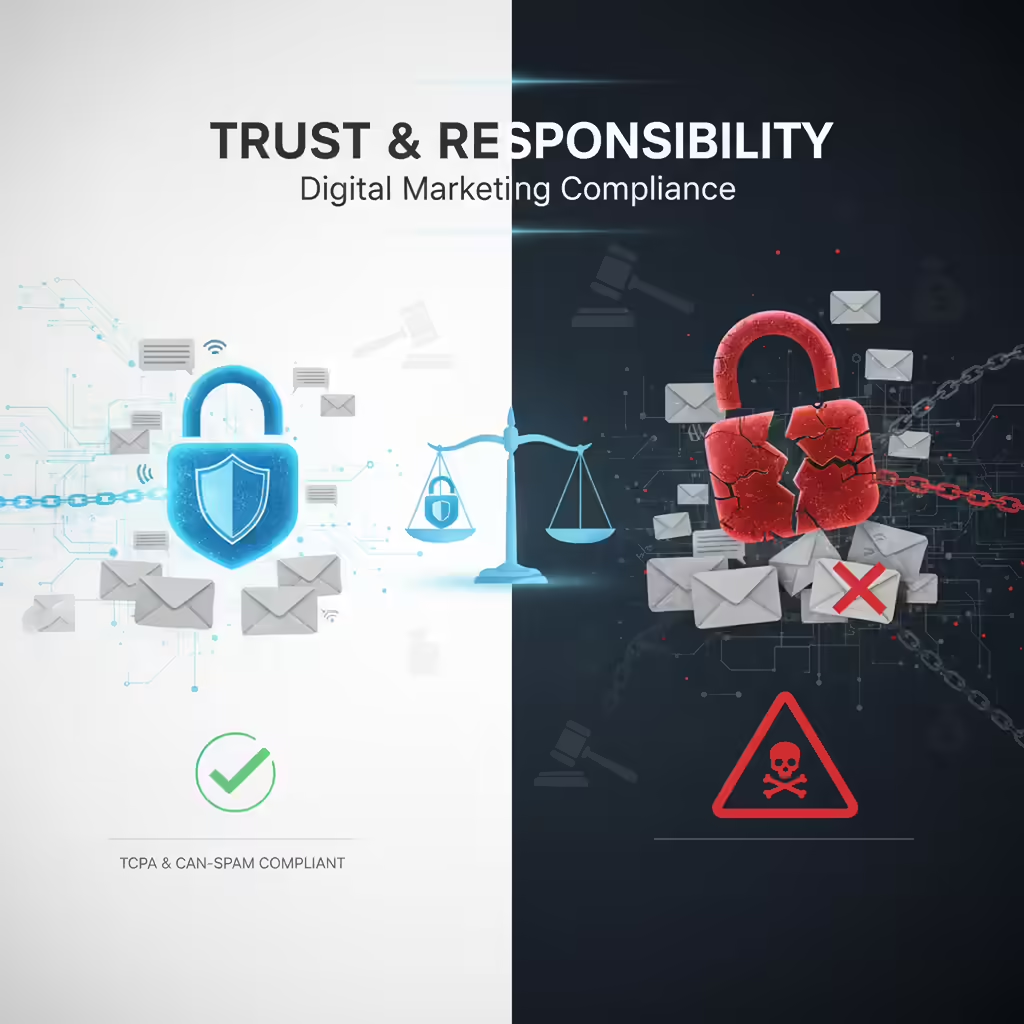
The power of direct-to-consumer channels like SMS and email comes with significant responsibility. Failure to adhere to legal and ethical standards can result in massive fines, damaged sender reputation, and an irreversible loss of customer trust.
SMS Compliance Checklist: How to Adhere to the TCPA
The Telephone Consumer Protection Act (TCPA) governs SMS marketing in the United States and is strictly enforced. Key requirements include:
Prior Express Written Consent: This is the cornerstone of TCPA compliance. Businesses must obtain clear, unambiguous consent from consumers before sending them marketing text messages. This consent cannot be a condition of purchase, and opt-in forms cannot use pre-checked boxes.
Clear Opt-Out Mechanism: Every message must provide a simple and clear way for consumers to opt out, such as replying with "STOP." These requests must be honored immediately.
Quiet Hours: Marketing texts are prohibited from being sent before 8 a.m. or after 9 p.m. in the recipient's local time zone.
Content Restrictions (SHAFT): The industry prohibits messages containing content related to Sex, Hate, Alcohol, Firearms, and Tobacco.
Email Compliance Checklist: Following the CAN-SPAM Act
The CAN-SPAM Act sets the rules for commercial email in the U.S. Key provisions include:
Accurate Sender Information: The "From," "To," and "Reply-To" fields must be accurate and identify the person or business who initiated the message.
Valid Physical Address: Every email must include the sender's valid physical postal address.
Honoring Opt-Out Requests: Businesses must provide a clear and conspicuous way to opt out of future emails and must honor such requests promptly.
Adhering to these regulations is more than a legal necessity; it is a strategic advantage. The strict opt-in requirements of TCPA, for example, act as a powerful filter, ensuring that an SMS list is composed only of highly engaged and willing recipients. This built-in list hygiene is a primary driver of the channel's phenomenal performance metrics. Compliance, therefore, is not a barrier to success but a foundational component of it.
Combine SMS and Email with Automation for the Best Results
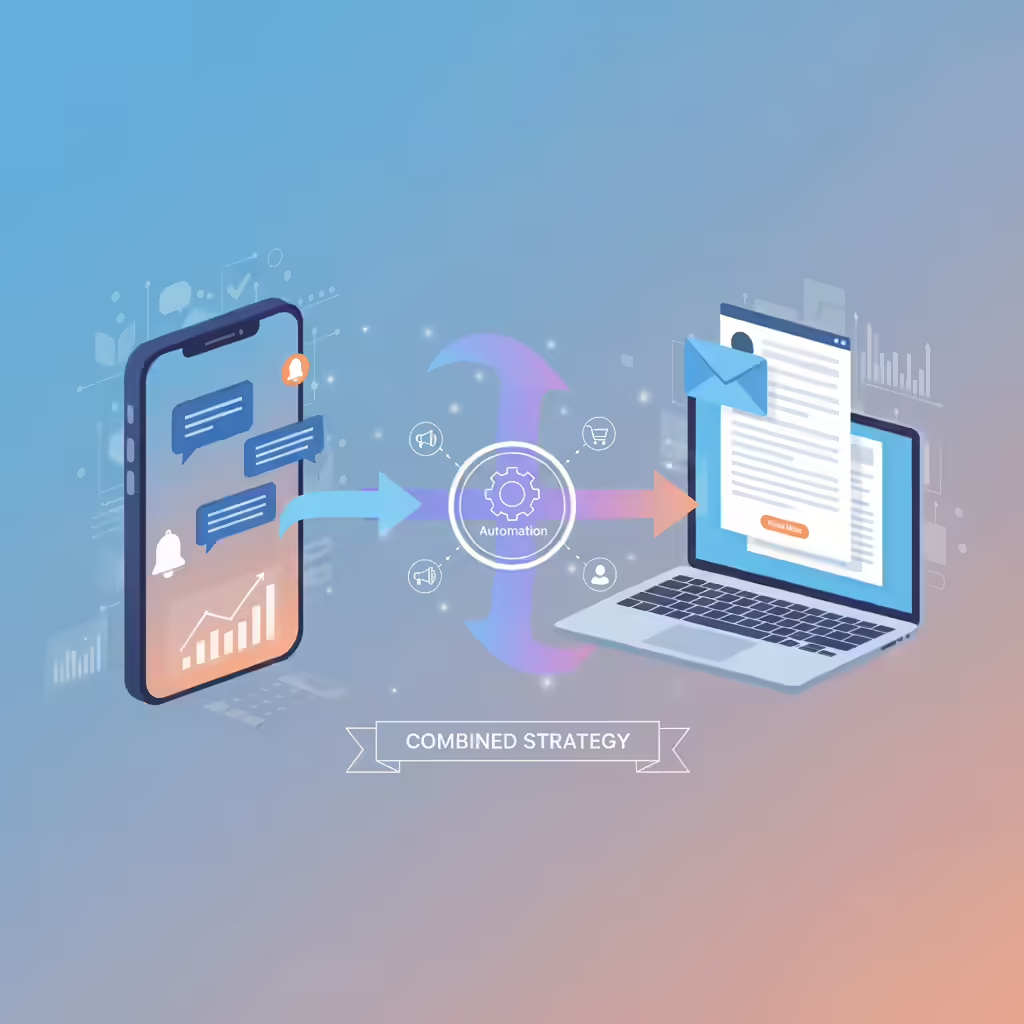
The data is unequivocal: for immediate, high-impact communication that demands a response, SMS marketing is in a class of its own. Its near-perfect open rates and rapid engagement make it an essential tool for any modern sales and marketing team. At the same time, email remains the undisputed champion of detailed, long-form content, providing the space necessary to build brand affinity, educate customers, and nurture leads through a complex buying journey.
The debate over which channel is "better" is obsolete. High-performing organizations no longer see them as competitors but as complementary components of a single, unified strategy. The true challenge lies in orchestrating the interplay between them—using email to set the stage with rich content and SMS to deliver the critical, time-sensitive cue that drives action.
At scale, managing this sophisticated, dual-channel strategy manually is not just inefficient; it is impossible. Automation is the engine that unlocks the full potential of an integrated communication strategy. It enables businesses to respond to customer behavior in real-time, delivering perfectly timed, contextually relevant messages on the channel most likely to be effective. This is the future of customer engagement—a seamless conversation that is not defined by the limitations of a channel, but by the needs of the customer.
Ready to stop choosing between speed and substance and start leveraging both? See how an automated sales engagement platform can unify your SMS and voice communication into a single, powerful workflow that drives revenue and builds lasting customer relationships. Schedule a demo today.


